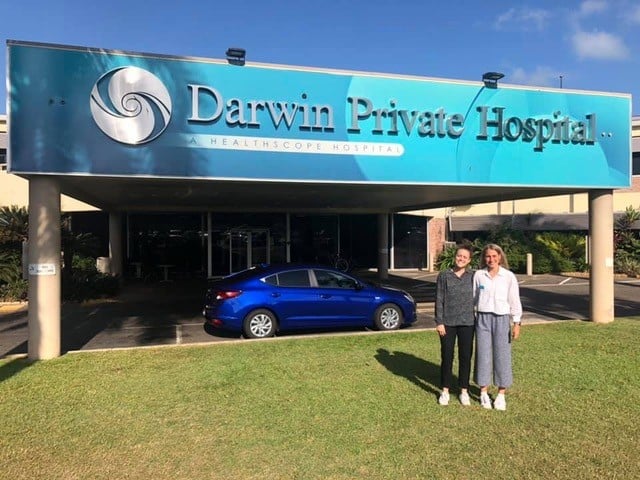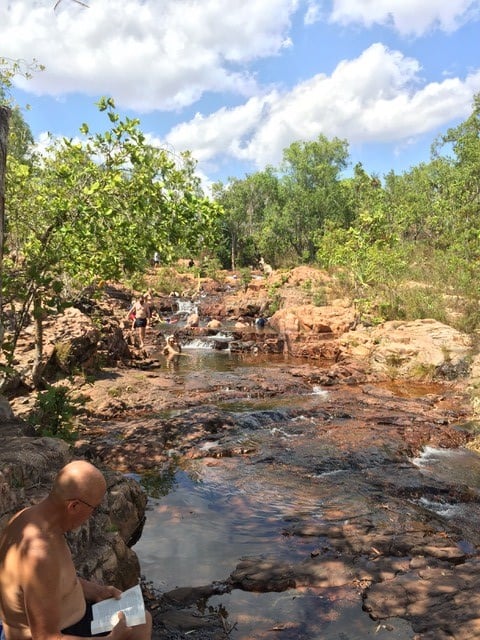Our time in the ‘Top End’ – A rural placement with Deakin Dietetics
August 14, 2020
Our next blog post has been contributed by Alice Bleathman and Georgia Walker, dietetics students from Deakin University. Alice and Georgia undertook a four-week rural placement in the Darwin during 2019 as a part of their studies. If you would like to know more about studying dietetics at Deakin, click here.
If anyone had told us at the beginning of our degree that we’d have opportunity to complete one of our dietetics placements in Darwin, we would have laughed. Fast forward a few months, one community dietetics placement, and many (many) assignments later, and that is exactly where we ended up.
During a dietetics degree at Deakin, students are placed into one of two streams. We were both in Stream B, which meant we completed both community and food service placements in the first half of the degree, and a clinical placement in the second half. We were fortunate enough to be selected as the two students to travel to Darwin for a four-week food service placement.

Darwin Private Hospital
So, except for the additional 20 degrees and replacing puffy jackets and umbrellas with sunscreen and insect repellent, how does a placement in Darwin differ to one in Melbourne?
On our first day, we were woken by the Jabiru crouching over the steamy asphalt. Over breakfast, we watched Sam Mac give his usual weather report on Sunrise; “Melbourne 15 degrees and chance of rain…Brisbane 23 degrees and possible shower…Darwin, 35 degrees and sunny”. Unbeknownst to us (or at least Alice), this weather would be unrelenting and continue for the whole four weeks.
The first week was about settling in to our host hospital – Darwin Private (DPH). We were introduced to our supervisor, the food service staff, and other allied health members including the physiotherapists, occupational therapists, and speech pathologists. DPH is a 110 bed hospital with four wards. The hospital is small, especially when compared to those within Melbourne. Due to the lack of funding, many health professionals undertook several roles within the hospital. This sharing of roles, although vital, was also very confusing for us, particularly when a staff member was a receptionist one day, then became an occupational therapist the next.
Nevertheless, we left the hospital on our first smiling from ear to ear and adrenaline souring through our veins. As a treat, we decided to head down to the beach to cool off. And when we mean the beach, we mean the waterfront with a man-made lagoon and sand imported from India (because, crocodiles).
The purpose of our time at DPH was to assess and nutritionally analyse the current menu in line with hospital menu standards. Picking the meals apart, we weighed a total of 83 main meals, mid-meals and drinks, then compared these to the current Victorian Standards. Week two meant it was time to audit. We were at placement from 7am until 9pm with a midday (beach) break. Long hours and full stomachs from the endless amounts of meals we audited became the norm. Despite the common belief, the hospital food at DPH was incredibly delicious.

Litchfield National Park
During week four we had the rare opportunity to observe two surgeries. The first was a gastric sleeve. A gastric sleeve is a surgery for weight loss that involves the removal of a large part of the stomach. Thankfully, both of us have stomachs of steel. Surgery two was the removal of a gastric band. A gastric band is also a type of weight loss surgery that involves placing a silicone band around the upper part of the stomach to decrease the stomach size and subsequent food intake.
The rest of week three was filled with many more incredible opportunities. We were fortunate to observe a consult regarding a patient who was newly diagnosed with cancer, and to attend a professional development session about the new texture modified food standards. Between the days at the hospital, we enjoyed the beautiful afternoon sun, relaxed at the outdoor cinema, and ate curry while watching the sun set at Mindil beach.
As quickly as we had first stepped into DPH, we were in the fourth and final week of placement. The majority of week four was spent analysing data, writing up our report and presenting everything we had found to the team at DPH. What we found over the four weeks sparked a lot of conversation. We were later assured by the general manager of DPH that things are going to change in a positive way because of what we had found and recommended during our four week placement.
Weekends meant time for kayaking, swimming in lagoons and sun-baking in the rays of the harsh Top End sun. We also visited Litchfield National Park, home to several stunning waterfalls that cascade into crystal clear pools, iconic magnetic termite mounds and clusters of weathered sandstone pillars. Lucky for us we beat the wet season, the torrential rain and the wildlife that comes with it (cue: crocs).
After four amazing weeks, our time in Darwin came to an end. Except for the sock tans and mosquito scars, we both came home with knowledge and memories that we will cherish forever. We would both like to take this time to encourage anyone considering a rural/remote placement to take the plunge. Alongside the practical knowledge you build, these types of placements help to expose students with opportunity to build their confidence and independence, facilitate a high sense of autonomy and responsibility, gain understanding of cultural diversity and safety, and also expose students to a wide variety of tasks and diverse patient mix.